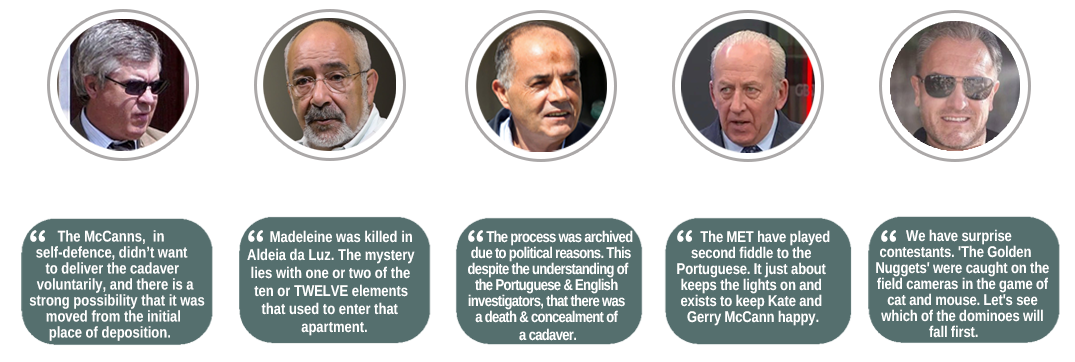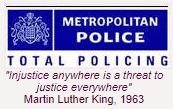Current date/time is 24.11.24 14:52
Latest topics
by crusader Today at 14:09
» What really Happened? Part 3 - Gerry
by PeterMac Today at 13:02
» Undercover CIA agent explains the issue of child trafficking and how to protect your children
by Jojo1 20.11.24 0:38
» CMOMM's Newsletters of Trending Topics and Publications
by Jill Havern 19.11.24 15:11
» Letter from PeterMac to The Rt Hon Priti Patel: OPERATION GRANGE - REPORTED DISAPPEARANCE OF MADELEINE BETH MCCANN
by JB2025 19.11.24 14:52
» The Strange World of Jeffrey Epstein
by CaKeLoveR 18.11.24 10:52
» 'VIDEO OF THE DAY'
by CaKeLoveR 18.11.24 8:02
» Those incredibly 'unreliable' DOGS............again!
by Jill Havern 15.11.24 13:52
» Kate and Gerry and New Zealand?
by pinkgladioli 06.11.24 15:57
» Ricardo Cunha - Goncalo Amarals' cousin, shot dead in London - 11 September 2010
by partridge 05.11.24 17:02
» Letter from PeterMac to Operation Grange dated 6th May re: Bernt Stellander, The Foreign Detective's, new book 'The Sudden Impulse'
by CaKeLoveR 05.11.24 11:55
» "The Hills are alive - with the sound of Barking"
by Jill Havern 03.11.24 23:33
» Retrospection: CMOMM from the beginning to the end
by Nina 03.11.24 23:13
» Christian Brueckner: To be or not to be
by CaKeLoveR 03.11.24 11:59
» Birth of Madeleine
by Bird131 30.10.24 14:01
» PeterMac's FREE e-book: What really happened to Madeleine McCann?
by Jill Havern 28.10.24 18:47
» DNA and BIOLOGICAL PARENTS of MADELEINE
by pinkgladioli 23.10.24 13:05
» Did Madeleine have any strange health conditions?
by sandancer 16.10.24 15:11
» PeterMac's FREE e-book. Chapter 62: Pool Photo Proves Madeleine Was Dead
by Keelafreeze 13.10.24 20:51
» PeterMac's FREE e-book: CHAPTER 63 Addendum A response to critiques of Chapter 63 – SmithGerryMan
by Silentscope 13.10.24 14:51
» Flight bookings
by Silentscope 13.10.24 13:10
» What Do Madeleine McCann’s Siblings Really Know About Her Disappearance?
by CaKeLoveR 10.10.24 11:05
» Latest from PeterMac's FREE e-book: CHAPTER 63 SMITH-GERRY-MAN SCRUTINISED
by Jojo1 07.10.24 16:37
» Maxine Carr 20 years after Soham - 'White wedding, motherhood and besotted husband'
by Bluebagthepirate 06.10.24 7:54
» Happy Birthday Gonçalo Amaral
by Clishmaclaver 02.10.24 22:54
» NEW VIDEO :) Do you BELIEVE the McCanns OR the BLOOD & CADAVER DOGS?
by Jimtheblue 27.09.24 21:11
» Christian Brueckner: To be or not to be
by MaxHeadroom 26.09.24 23:43
» The Manchester Arena Incident: A disaster killing 22 and injuring 1,037 - or an elaborate hoax? !! NOW INCLUDES EXTRACTS FROM NEW BOOK by Iain Davis !!
by seedsofdoubt 18.09.24 12:09
» What really happened? Part 1 - The timeline
by AnneCGuedes 15.09.24 17:50
» Christopher Laverack murder probe: 'Uncle was killer'
by Jimtheblue 07.09.24 0:28
» Who killed JonBenet Ramsay?
by Amy Dean 31.08.24 22:45
» Criminal Profiler, Pat Brown: Profile of the Disappearance of Madeleine McCann
by Jill Havern 29.08.24 5:45
» What really happened? Part 2 - Russell
by Shash T 24.08.24 20:06
» Calpol Night ORIGINAL!
by Bluebagthepirate 23.08.24 12:42
» Help needed to find a photo of the McCanns in Spain
by pinkgladioli 20.08.24 20:24
» Timeline questiom
by AnneCGuedes 18.08.24 21:47
» Madeleine McCann: “A WEB OF LIES” | Ex Scotland Yard Jon Wedger
by Nina 18.08.24 1:00
» The Mark Williams-Thomas thread
by Ladyinred 11.08.24 16:27
» Peters e book and the dossier of death
by Paddingtom 11.08.24 14:49
» The 'make-up photo'
by crusader 09.08.24 18:35
» Police probing disappearance of Madeleine McCann 'set to get hundreds of thousands of pounds in new funding'
by Cake Lover 05.08.24 21:32
» PeterMac's FREE e-book - Chapter 61. Brückner’s “Arrest Warrant “ cancelled.
by PeterMac 31.07.24 0:02
» Gerry McCann calls for Leveson press inquiry part two - but Starmer says no Thur 25 Jul 7.08pm • The father of Madeleine McCann is calling on Sir Keir Starmer to proceed with the second part of the Leveson inquiry.
by Bluebagthepirate 30.07.24 9:58
» Is it a paradox?
by crusader 29.07.24 17:15
» Extract from Jon Clarke's new book: 'My Search for Madeleine McCann'
by PeterMac 25.07.24 12:43
» Sonia Poulton Loses Libel Preliminary Trial
by MHWitchfinder 21.07.24 23:08
» Portuguese Geography
by Cake Lover 18.07.24 10:32
» Wot? no Smithman
by crusader 15.07.24 11:01
» Chapter 60. IS THERE NO END TO CLARKE'S "MISPREPRESENTATION OF FACT" ?
by PeterMac 05.07.24 13:08
» Nóra Quoirin - found dead in Malaysian jungle on 13/8/2019
by Silentscope 28.06.24 18:06
» Jon Wedger, Police whistleblower talks about human trafficking and child sex abuse
by Setian 28.06.24 17:46
» Key questions I want answers to
by Paddingtom 28.06.24 11:03
» Photographs Revisited - general
by Ladyinred 21.06.24 21:51
» Gerry's Blogs - what's changed in the last 6 years?
by Silentscope 16.06.24 14:20
» questions/observations.of the mccann case
by Ashley1999 13.06.24 16:30
» YES or NO? Did Dr David Payne visit Dr Kate McCann on the evening Madeleine was reported missing? - 20 CONTRADICTIONS which suggest that this visit never took place
by AnneCGuedes 12.06.24 15:54
» Smithman theory
by AnneCGuedes 11.06.24 23:28
» Police Whistleblower Maggie Oliver: I witnessed police failing victims during the Rochdale grooming gangs scandal. How can we STILL allow this to happen?
by Jill Havern 05.06.24 8:58
» Anne A. Corrêa-Guedes: MADDIE Fabrication d’un mythe
by AnneCGuedes 04.06.24 19:53
» BBC News - Katrice Lee disappearance. (Similarities to McCann investigations ?)
by Liz Eagles 01.06.24 19:47
» SMITHMAN 5: The evidence of the Smith family from Drogheda, Ireland: the TWELVE sets of contradictions
by crusader 28.05.24 23:56
» Madeleine McCann Reward Fund
by Honesty 26.05.24 14:04
» Ex Police Gary Waterman Turns Whistleblower Against Establishment (Madeleine McCann mentioned)
by Jill Havern 21.05.24 7:06
» Picture Gallery
by Jill Havern 16.05.24 14:16
» Madeleine McCann investigation set to receive fresh cash injection on eve of 17th anniversary
by Jill Havern 14.05.24 11:36
» Ex-Metodo3 investigator Julian Peribañez heading back to PdL to explore leads not investigated by PJ
by Jill Havern 13.05.24 8:42
» SMITHMAN 12: Can anyone who still believes that the Smiths saw Gerry McCann carrying Madeleine satisfactorily answer ANY of these 60 Questions ?
by sharonl 12.05.24 22:05
» Madeleine McCann's parents say 'we're waiting for you' in 20th & 21st birthday messages
by Silentscope 12.05.24 18:56
» I Regret Posting Online That I Was Madeleine McCann
by crusader 09.05.24 20:30
» ***Missing People Bike Ride now under way (Kate McCann, Simon Cowell and Stephen Fry back Missing People campaign on Twitter)
by Liz Eagles 06.05.24 13:59
» The Crown - v - McHaggis and McHaggis
by Cake Lover 05.05.24 13:02
» Madeleine McCann's parents share heartbreaking update on 17th anniversary of daughter's disappearance
by Jill Havern 05.05.24 11:12
» Ben Needham's mum calls for same amount spent on Madeleine McCann for missing son
by Jill Havern 04.05.24 8:48
» Madeleine McCann's parents share heartbreaking update on 17th anniversary of daughter's disappearance
by Jill Havern 03.05.24 8:38
» Madeleine McCann investigation set to receive fresh cash injection on eve of 17th anniversary
by Jill Havern 01.05.24 19:37
» Netflix probes Madeleine McCann disappearance in new documentary
by Jill Havern 26.04.24 9:29
» In Pursuit of the Truth, by DCI Clive Driscoll
by Cake Lover 25.04.24 21:16
» New from PeterMac's FREE e-book: CHAPTER 58 The Trials and Tribulations of Christian Brückner
by Jill Havern 23.04.24 19:19
» Was the missing Madeleine McCann in Mallorca after all?
by Silentscope 14.04.24 15:13
» Leave No Stone Unturned
by Silentscope 06.04.24 18:00
» UK Government cover up of Madeleine Beth McCann's death and a complaint about Asst. Commissioner Mark Rowley
by Jimtheblue 31.03.24 1:21
» The disappearance of Sebastian Rogers
by Amy Dean 27.03.24 17:40
» The breakthrough new DNA evidence that could find JonBenét Ramsey's killer | 60 Minutes Australia
by Jimtheblue 21.03.24 21:59
» The Hampstead Satanic Paedophile Hoax
by Cake Lover 12.03.24 19:02
» Accounts 2023
by sharonl 09.03.24 0:02
» Dr Martin Roberts - 'A Nightwear Job'
by rlady 08.03.24 23:18
» Man who sent his two top CPS lawyers to Portugal, in Madeleine McCann case, will become Labour MP in May
by sharonl 24.02.24 18:51
» New from PeterMac: Chapter 57: STOP PRESS: BRÜCKNER HAS SOME MATES ROUND FOR A BIRTHDAY PARTY
by Jill Havern 15.02.24 20:56
» Letter to Downing Street: Reasons why public need report on Operation Grange (plus reply)
by sharonl 10.02.24 16:12
» THE CASE OF THE LEGLESS WAITER - PARAISO RESTAURANT CCTV
by Silentscope 08.02.24 10:50
» New from PeterMac: Chapter 56: Still no update
by Jill Havern 04.02.24 19:01
» Sonia Poulton Being Sued
by seedsofdoubt 02.02.24 23:24
» DID MADELEINE MCCANN DIE ON SUNDAY 29 APRIL, FOUR DAYS BEFORE SHE WAS REPORTED MISSING? – STRONG EVIDENCE THAT SHE DID
by seedsofdoubt 02.02.24 9:55
» Sonia Poulton is the victim of stalking by Darren Laverty, says Crown Prosecution Service
by MHWitchfinder 31.01.24 20:15
» New from PeterMac: CHAPTER 55. BRÜCKNER'S LONG DRIVE SOUTH
by Jill Havern 31.01.24 14:46
» A McCann-believer changes her mind
by AskTheDogsSandra 28.01.24 10:03
» What happened to Madeleine McCann? No. 3 - Operation Grange, 2011 to 2016 50 more facts about the case that the British media are not telling you
by sharonl 27.01.24 12:39
» 50 ridiculous stories the British media "ARE" telling you
by sharonl 27.01.24 12:24
» McCann children 'were not alone in apartment'
by Silentscope 25.01.24 16:18
Justice or Cover-up?

Where, when and why was this photo taken?
Death Toll in McCann Case

Gerry McCann called for an example to be made of 'trolls'. SKY reporter Martin Brunt doorstepped Brenda Leyland on 2 October 2014 after a 'Dossier' was handed in to Police by McCann supporters. She was then found dead in a Leicester hotel room two days later having, apparently, taken her own life. Brenda paid the price.
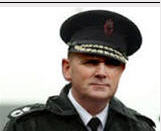
Ex-Deputy Chief Constable, Jim Gamble QPM congratulated SKY reporter Martin Brunt for doorstepping Brenda Leyland.
A Risky Gamble
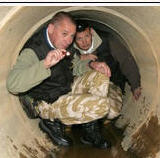


Colin Sahlke died suddenly in mysterious circumstances with a significant amount of morphine in his system. At the Inquest the coroner said there was no evidence as to how he had come to take morphine, and no needle mark was found. Gerry McCann had met Sahlke before he helped with the search but did not show any concern for his death. Link
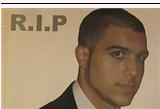

Snr Gonçalo Amaral's cousin, Ricardo Cunha, shot dead in London Sept 2010. Murder still unsolved. Link

Bloodied body of Kevin Halligen, who conned Maddie Fund of £583,00, is found dead at his Surrey mansion. Daily Mail
Ex-Met DCI Colin Sutton: "The most likely scenario is that Madeleine was stolen to order by slave traders and smuggled into Africa for a rich family who wanted a white child."
Ex-Met DCI Andy Redwood had a "revelation moment" on BBC1's Crimewatch on 14th October 2013 when he announced that Operation Grange had eliminated the Tanner sighting - which opened up the 'window' of opportunity' from 3 minutes to 45 minutes, in accordance with their remit, to allow the staged abduction to happen.

Former Assistant Commissioner Mark Rowley made public on national TV that Operation Grange is a complete fraud.
Pat Brown, Criminal Profiler
More than £12million spent so far on one victim.

Grenfell: £5million shared between families of the 72 victims.
